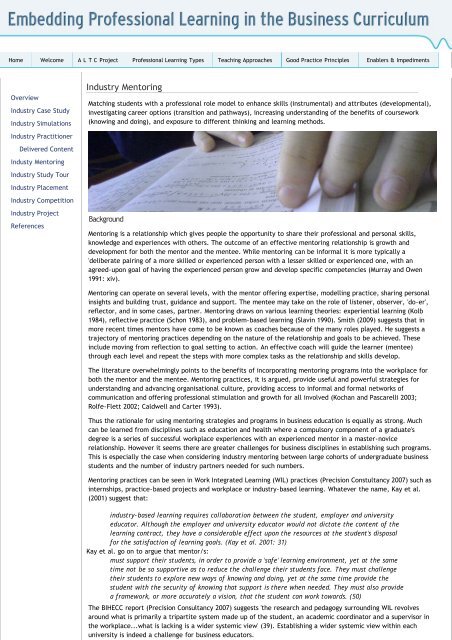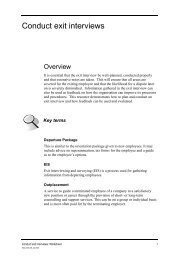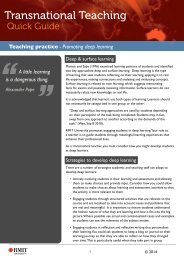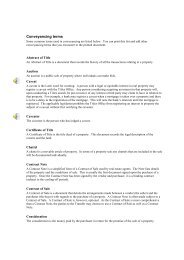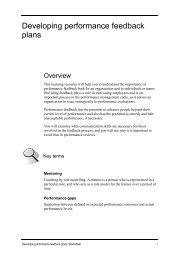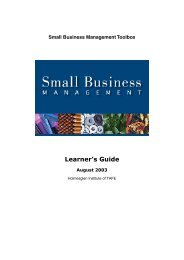PDF of website - Bad Request - RMIT University
PDF of website - Bad Request - RMIT University
PDF of website - Bad Request - RMIT University
Create successful ePaper yourself
Turn your PDF publications into a flip-book with our unique Google optimized e-Paper software.
Home Welcome A L T C Project Pr<strong>of</strong>essional Learning Types Teaching Approaches Good Practice Principles Enablers & Impediments<br />
Overview<br />
Industry Case Study<br />
Industry Simulations<br />
Industry Practitioner<br />
Delivered Content<br />
Industy Mentoring<br />
Industry Study Tour<br />
Industry Placement<br />
Industry Competition<br />
Industry Project<br />
References<br />
Industry Mentoring<br />
Matching students with a pr<strong>of</strong>essional role model to enhance skills (instrumental) and attributes (developmental),<br />
investigating career options (transition and pathways), increasing understanding <strong>of</strong> the benefits <strong>of</strong> coursework<br />
(knowing and doing), and exposure to different thinking and learning methods.<br />
Background<br />
Mentoring is a relationship which gives people the opportunity to share their pr<strong>of</strong>essional and personal skills,<br />
knowledge and experiences with others. The outcome <strong>of</strong> an effective mentoring relationship is growth and<br />
development for both the mentor and the mentee. While mentoring can be informal it is more typically a<br />
'deliberate pairing <strong>of</strong> a more skilled or experienced person with a lesser skilled or experienced one, with an<br />
agreed-upon goal <strong>of</strong> having the experienced person grow and develop specific competencies (Murray and Owen<br />
1991: xiv).<br />
Mentoring can operate on several levels, with the mentor <strong>of</strong>fering expertise, modelling practice, sharing personal<br />
insights and building trust, guidance and support. The mentee may take on the role <strong>of</strong> listener, observer, 'do-er',<br />
reflector, and in some cases, partner. Mentoring draws on various learning theories: experiential learning (Kolb<br />
1984), reflective practice (Schon 1983), and problem-based learning (Slavin 1990). Smith (2009) suggests that in<br />
more recent times mentors have come to be known as coaches because <strong>of</strong> the many roles played. He suggests a<br />
trajectory <strong>of</strong> mentoring practices depending on the nature <strong>of</strong> the relationship and goals to be achieved. These<br />
include moving from reflection to goal setting to action. An effective coach will guide the learner (mentee)<br />
through each level and repeat the steps with more complex tasks as the relationship and skills develop.<br />
The literature overwhelmingly points to the benefits <strong>of</strong> incorporating mentoring programs into the workplace for<br />
both the mentor and the mentee. Mentoring practices, it is argued, provide useful and powerful strategies for<br />
understanding and advancing organisational culture, providing access to informal and formal networks <strong>of</strong><br />
communication and <strong>of</strong>fering pr<strong>of</strong>essional stimulation and growth for all involved (Kochan and Pascarelli 2003;<br />
Rolfe-Flett 2002; Caldwell and Carter 1993).<br />
Thus the rationale for using mentoring strategies and programs in business education is equally as strong. Much<br />
can be learned from disciplines such as education and health where a compulsory component <strong>of</strong> a graduate's<br />
degree is a series <strong>of</strong> successful workplace experiences with an experienced mentor in a master-novice<br />
relationship. However it seems there are greater challenges for business disciplines in establishing such programs.<br />
This is especially the case when considering industry mentoring between large cohorts <strong>of</strong> undergraduate business<br />
students and the number <strong>of</strong> industry partners needed for such numbers.<br />
Mentoring practices can be seen in Work Integrated Learning (WIL) practices (Precision Constultancy 2007) such as<br />
internships, practice-based projects and workplace or industry-based learning. Whatever the name, Kay et al.<br />
(2001) suggest that:<br />
industry-based learning requires collaboration between the student, employer and university<br />
educator. Although the employer and university educator would not dictate the content <strong>of</strong> the<br />
learning contract, they have a considerable effect upon the resources at the student's disposal<br />
for the satisfaction <strong>of</strong> learning goals. (Kay et al. 2001: 31)<br />
Kay et al. go on to argue that mentor/s:<br />
must support their students, in order to provide a 'safe' learning environment, yet at the same<br />
time not be so supportive as to reduce the challenge their students face. They must challenge<br />
their students to explore new ways <strong>of</strong> knowing and doing, yet at the same time provide the<br />
student with the security <strong>of</strong> knowing that support is there when needed. They must also provide<br />
a framework, or more accurately a vision, that the student can work towards. (50)<br />
The BIHECC report (Precision Consultancy 2007) suggests 'the research and pedagogy surrounding WIL revolves<br />
around what is primarily a tripartite system made up <strong>of</strong> the student, an academic coordinator and a supervisor in<br />
the workplace...what is lacking is a wider systemic view' (39). Establishing a wider systemic view within each<br />
university is indeed a challenge for business educators.


